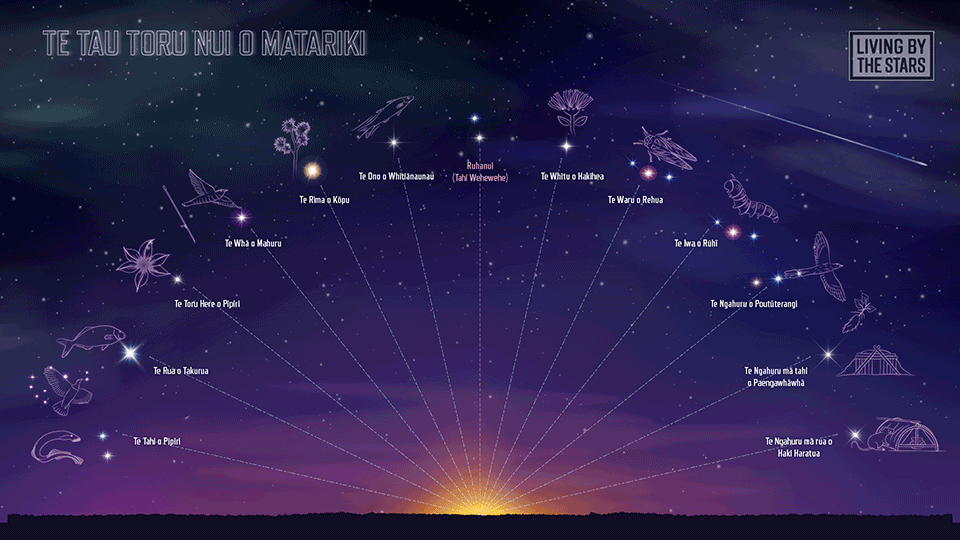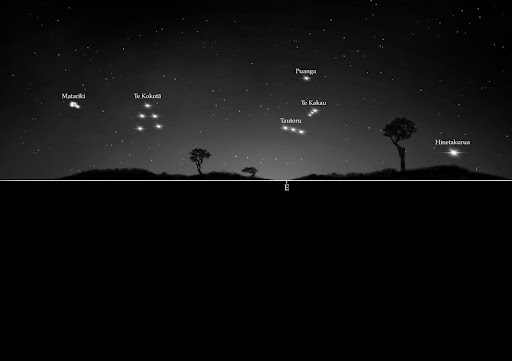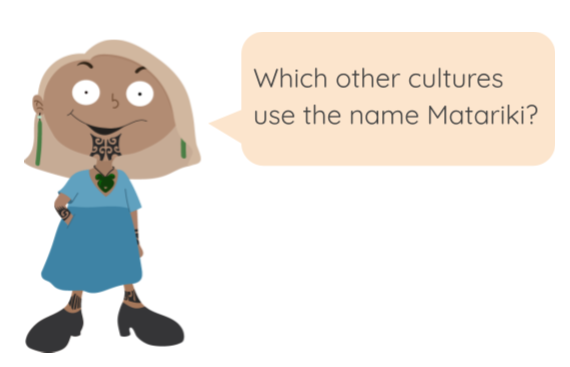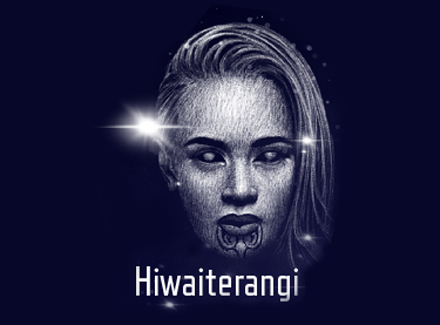
EXPLORE / TŪHURA learning intentions:
- We are EXPLORING to identify the Māori perspective of astronomical and cosmological links relevant to Matariki according to Rangi Matamua.
- We are EXPLORING Matariki by comparing and contrasting Rangi Matamua’s understanding of Matariki with my own cultural narrative.
- We are EXPLORING...
Matariki hunga nui–Matariki brings us together

“Matariki of many people”
This whakataukī refers to the Matariki festivities and people celebrating and gathering together.
Jamie and Rangi talk about the plans to celebrate Matariki as a public holiday in Aotearoa, 2022:
A time to reflect and celebrate
During Matariki we reflect and remember, celebrate our efforts, and make plans. When Matariki rises we celebrate the Māori New Year. It is a time when people can relax and entertain themselves with games, music, art, film, dance and other interests. Matariki is also a time to mourn our dead (remember the star Pōhutukawa). The mourning period is after Matariki sets and before it rises. We remember people who have died during the past year and honour their memory by sharing stories, songs, or creating something. The names of our dead are often called during karakia.
Karakia to Matariki – This karakia evokes our connection and appreciation for Matariki and the whetū (stars) in her constellation (Dr Rangi Matamua):
Karakia to Hiwaterangi – This karakia to a daughter of Matariki, recognises the many significant events since Matariki last rose and casts blessings over our hopes, dreams, wishes and aspirations (Dr Rangi Matamua):

“The harvest ends when Matariki sets”
This whakataukī refers to when Matariki sets in the west, that it is time to harvest before it rises again in the Māori New Year. This signals the need to prepare for winter.
A time to plan
Matariki is a time to plan. Predictions about the coming year can be made by paying close attention to the brightness, colour, and distance of stars. When they appear hazy or seem close together, a cold season is predicted. When they are clear and seem further apart, a good season will follow.
The appearance of each star determines a combination of possibilities. The ability to understand star appearances takes many years of observation.
Wishes and plans can be cast toward the star Hiwa-i-te-rangi, the star of promises and prosperity.

The study of the sky has been happening ever since people looked up and wondered. Astronomers are wise observers of the night sky. They noticed that when Earth moves through the seasons, different stars rise with the sun.
Māori astronomers provide a unique understanding of the sky above Aotearoa New Zealand. They observe, assess and draw conclusions based on the predictable movement of the moon, stars and planets across the sky.
One of the best ways of remembering new information is through stories and metaphors which explain complex ideas e.g. the stars form a canoe travelling through the sky.
This image shows the maramataka (the Māori lunar calendar) and corresponding star movements. Each lunar month is identified by the star, or stars, which rise with the sun during the night of the new moon. The month of Ruhanui is added during the winter of the third year of the three year calendar.

Ko whea a Matariki?–Where is Matariki?
To locate Matariki, look north-east toward the horizon, before sunrise. Go high if you live near ridges or buildings. Look for stars, clusters and constellations you recognise.
Find Tautoru that form the three bright stars which form the base of The Pot, or Orion’s Belt, the constellation of Taurus. These stars are some of the brightest in the night sky.
Follow Tautoru in a straight line along the horizon toward the left.
Look for a triangle of stars. This is Te Kōkota, Mata Kaheru, or Hyades (the face of Taurus the bull).
Look further to the left.
See the small group of clustered stars. This is Matariki.

Image: Matariki_location, ©Living by the Stars
Matariki is an important navigation feature of the night sky. It forms the prow of Te Waka o Rangi (the sky canoe). The waka extends along the horizon, toward Tautoru (the three stars of the Pot) to the bright star Takurua (Sirius).
Some stars, constellations, and planets have different names given by different iwi. For example, the Southern Cross is Te Pae Māhutonga, or Te Punga (the anchor) amongst other names. Some of the names depend on how the stars look in the sky from different tūrangawaewae, as well as local seasonal activity.

Image: Te Waka o Rangi, ©Living by the Stars
Another important star indicating the beginning of the Māori New Year is Puanga (Rigel) which appears above Tautoru. This star rises at the same time as Matariki. Matariki has many names from many cultures. It is often called Pleiades from Greek culture, which tells the story of seven sisters who became stars. Here are a some names for Matariki from the Pacific:
Mataliki - Tonga, Nuie
Mataali’i -Samoa
Makali’i - Hawai’i
Matali’ - Tahiti
Matariki - Aotearoa, Cook Islands, Rapanui/Easter Island, Kiribati, Rapa, Pitcairn

Kōkōrangi Māori–Māori Astronomy
Seasons and stars
Observation and sharing knowledge is how we learn about season changes linked to the sun, moon and stars. Ocean tides and churn, the best time to plant, harvest, fish, hunt, work, and rest are all influenced by the energy of te whānau mārama (celestial bodies).
By paying attention to the stars and living in harmony with the seasons we can engage in more sustainable practises, like catching fish when fish are plentiful rather than all year.
People used to spend more time observing the sky. Now we have more information and spend less time observing our surroundings. We can learn to synchronise with the environment by observing activity in the sky and understanding the energy of the present moment.
Compare and contrast Rangi Matamua’s understanding of Matariki with their own cultural narrative of Matariki.
Rangi Matamua understanding of Matariki - LEARNZ
Teaching the Maori Lunar Calendar vs Gregorian Calendar
Move over astrology, it’s time to return to the Māori lunar calendar
Identify the Māori perspective of astronomical and cosmological links relevant to Matariki according to Rangi Matamua.
Ākonga/Students listen to the podcast from Te Papa’s Matariki and Māori astronomy where Rangi shares a Māori perspective of astronomical and cosmological links relevant to Matariki. While they listen, Ākonga/Students make notes of significant points regarding the astronomical and cosmological links relevant to Matariki that are shared. These notes will be used to inform your own podcast development later in the unit.
Podcast
Compare and contrast Rangi Matamua’s understanding of Matariki with their own cultural narrative of Matariki.
Rangi Matamua understanding of Matariki - LEARNZ
Teaching the Maori Lunar Calendar vs Gregorian Calendar
Move over astrology, it’s time to return to the Māori lunar calendar
Identify the Māori perspective of astronomical and cosmological links relevant to Matariki according to Rangi Matamua.
Ākonga/Students listen to the podcast from Te Papa’s Matariki and Māori astronomy where Rangi shares a Māori perspective of astronomical and cosmological links relevant to Matariki. While they listen, Ākonga/Students make notes of significant points regarding the astronomical and cosmological links relevant to Matariki that are shared. These notes will be used to inform your own podcast development later in the unit.
Podcast








